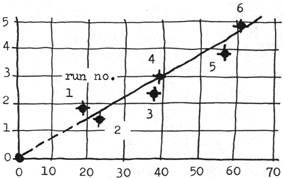| * DESIGN FILE * | Running speed trials: * P.1 * P.2 * ***T-SHIRTS*** |
|
PROCEDURE: Make at least three runs at different constant pedal rpms (about 20, 40, and 60 rpm), each repeated in opposite direction. (Six passes over course, minimum). [4] In each pass, record start and end of timed run when range marks line up at each end. Difference is elapsed time over course. During pass count number of pedal-pushes with one foot, from start to finish of course. This number, divided by elapsed time over course (in minutes) is pedal rpm. Calculate speed over course as follows:  Plot results on graph paper as follows: |
|
miles per hour |
 |
best straight line through 0,0 and most points pedal rpm |
|
PRESENTATION Display all data as follows: |
|
|
|
|
NOTES:
|
|
 |
© 2001-2013 by Philip Thiel Seattle WA USA |